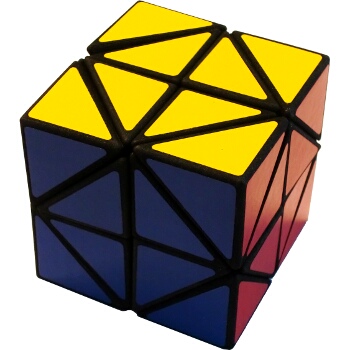
Above:Front view
Click a thumbnail to see its larger version and description.
A heavily restricted Super Z, redesigned for the sake of proving a mathematical point.
This puzzle was designed to give a whole new solving experience and the search for puzzles with few parts but multiple interesting orbits. The result is this restricted version of the Super Z which allows only one skewb-like turn and one 2x2x2-like turn, restricted to a half-turn.
Solver's Chop has multiple strange group-theoretic properties:
Both orbits of triangles consist of 8 pieces, and are isomorphic to a group known as PGL(2,7). This group has order 336 = 8 * 7 * 6, which is 120 times smaller than 8! = 40320, the order one would expect if all rearrangements of those pieces were reachable. The factorization of the order of these orbits describes how they solve: one can place 3 pieces anywhere, then the positions of the 5 remaining pieces are uniquely determined.
The corner pieces form separate orbits: one with 2 pieces, and one with 3 pieces. Surprisingly, these orbits are isomorphic - they are both groups of order 18. Even more surprisingly, they solve simultaneously - the orbit on 2 pieces is solved if and only if the orbit on 3 pieces is solved.
When one accounts for the fact that all 4 orbits have the same parity, we get that the total number of reachable positions could be as high as 336 * 336 * 18 / 2^2 = 508032. This turns out to be precisely the size of the group, which is easily checked in GAP.
This number is small enough that a computer can enumerate this group completely. In particular, this means we can compute God's number for this puzzle by brute force. GAP has a function to compute the growth function of the group, i.e. the number of positions reachable in n moves for any n. God's number for this puzzle is 52.
There are 6 permutations that require 52 moves to solve are permutations that only affect the corners.
Given that there are 6 pairs of identically-stickered parts, one might guess that the number of distinguishable reachable permutations is actually 508032 / 2^6 = 7938. In fact this is not the case: every reachable permutation is distinguishable. Only one of the 8-piece orbits has any identical-looking solutions. This does not reduce the number of distinguishable permutations for the whole puzzle because this is an odd permutation, and on all other orbits odd permutations are distinguishable from even permutations.
Edge length: 60 mm
Weight: 62 grams
Links

Contributors
No one has contributed to this page yet!
Collections
No one has added this puzzle to a collection yet!
Found a mistake or something missing?
Edit it yourself or
contact the moderator.





